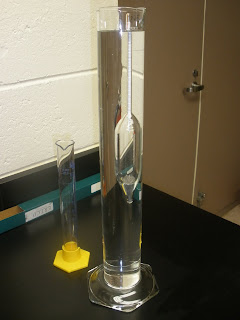
For comparison to data collected from a tempe cell analysis, knowledge of a soils texture can give insight into the correct soil moisture curve for a specific soil.
The Snapper Creek field site soil was analysed for %Organic Matter, %Gravel, and %Sand, Silt, and Clay Content.

Soil Samples were collected at the Snapper Creek Field Site for analysis.
The organic matter of the soil was determined through the Loss on Ignition method. Three 5 gram samples were placed in dried crucibles and heated in the Muffle for 12 hours at 105 deg C. The weight was recorded, then the samples were heated for 12 hours at 500 deg C. The difference in weight between the sample at 105 deg C and 500 deg C is the organic matter content of the soil.
The organic matter of the Snapper Creek Site was 7.89%
The soil sample was split in two using a No. 10 (2mm) sieve to seperate the large and small particles. The particles greater than 2mm in diameter are gravel. The (mass of dry gravel) / (mass of dry gravel + mass of dry small particles) was used to calculate the % gravel content of the soil.
The gravel content of the Snapper Creek Site was 19.12%
To determine the % sand, silt, and clay a texture test was completed using a hydrometer.

A hydrometer is an instrument that measures the specific gravity of a solution. Using a hydrometer to analyze soil texture is possible because of the principle of Stokes Law. Stokes Law states that particles of different sizes will fall at different rates in solution. By taking hydrometer readings at various times we can determine the size of the particles still in solution at that time.
Prior to starting the hydrometer test three 60 g soil samples were shaken over night in a 40 g/L Sodium Hexametaphosphate solution. The purpose of this solution is a dispersant, breaking up all of the clumped soil particles.
The soil samples were added to the sedimentation cylinders and filled to 1000 mL with DI water. One blank cylinder of DI water and dispersant solution was used to correct for variation in test conditions.

Prior to taking hydrometer readings the sedimentation cylinder is inverted for one minute to force all particles into solution.
 After inverting the cylinder the hydrometer is inserted into the cylinder and readings taken at 30 s and 60s. The 30 s and 60 s readings are taken three times by repeating the process. Hydrometer readings are taken at 30 s, 60 s, 90 min, and 24 hours.
After inverting the cylinder the hydrometer is inserted into the cylinder and readings taken at 30 s and 60s. The 30 s and 60 s readings are taken three times by repeating the process. Hydrometer readings are taken at 30 s, 60 s, 90 min, and 24 hours. 
The % sand, silt, and clay content is determined through equations relating the hydrometer readings to the desired parameters.
The Snapper Creek Soil was 63.25% Sand, 23.43% Silt, and 13.33% Clay, receiving the classification of a Sandy Loam.
Soil texture can be empirically related to soil water characteristics using equations developed in Saxton 1986 and Saxton 2006.
 Nicholas' expertise with parafilm kept the sedimentation cylinders sealed tight during shaking...
Nicholas' expertise with parafilm kept the sedimentation cylinders sealed tight during shaking... 
...The roof of the lab was not so lucky, as Tropical Storm Bonnie raged through TREC during the hydrometer test!
-Kevin
Nice pictures Kevin, thanks for blogging
ReplyDeleteGreat storm shot! The hydrometer test looks promising - it will be interesting to see Isaya's results also.
ReplyDelete